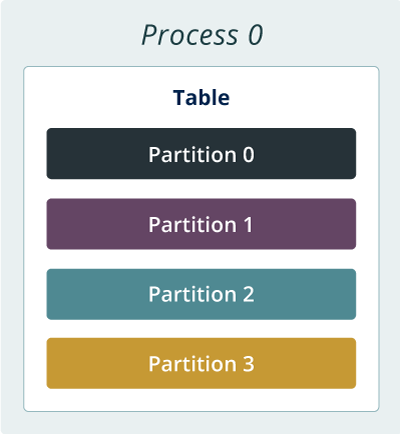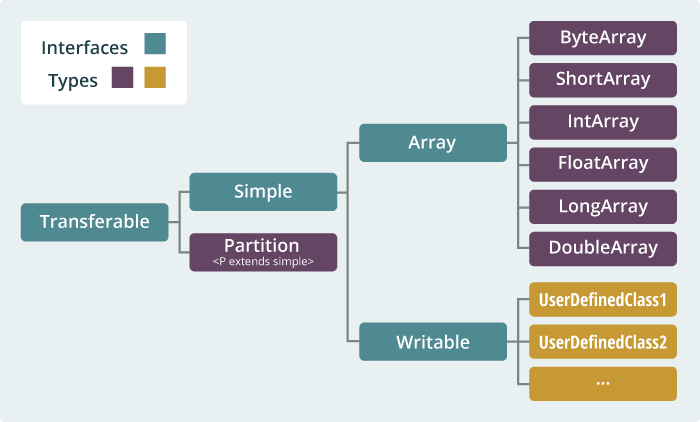
Harp provides three levels of data structures: arrays and objects, partition, and table. Arrays and Serializable objects are the basic data structures, which include:
ByteArray: an array with byte-type elementsShortArray: an array with short-type elementsIntArray: an array with int-type elementsFloatArray: an array with float-type elementsLongArray: an array with long-type elementsDoubleArray: an array with double-type elementsWritable: serializable object
Partition is a wraper of the data structures shown above. Every partition has an ID. In collective communication, partitions from different processors with the same ID will be merged. The merge operation is defined by PartitionCombiner.
Table is a container for partitions. It is a high-level data structure and the unit for collective communication.
Table and Partitions

An example of how to construct a table is:
Table<DoubleArray> table = new Table<>(0, new DoubleArrPlus());
for (int i = 0; i < numPartitions; i++) {
DoubleArray array = DoubleArray.create(size, false);
table.addPartition(new Partition<>(i, array));
}
In this example, it initiliazes a table which carries DoubleArray as the primitive data type. DoubleArrPlus is a PartitionCombiner used to define the merging operation of two partitions.
public class DoubleArrPlus extends PartitionCombiner<DoubleArray> {
public PartitionStatus combine(DoubleArray curPar, DoubleArray newPar) {
double[] doubles1 = curPar.get(); int size1 = curPar.size();
double[] doubles2 = newPar.get(); int size2 = newPar.size();
if (size1 != size2) {
return PartitionStatus.COMBINE_FAILED;
}
for (int i = 0; i < size2; i++) {
doubles1[i] = doubles1[i] + doubles2[i];
}
return PartitionStatus.COMBINED;
}
}
Data Abstraction

The data abstraction is shown above. Transferable is ae higher interface compare to other data structures and Simple is the sub-interface for all primitive data structures. Here is an example of the primitive data strucutres.
/*
* Copyright 2013-2016 Indiana University
*
* Licensed under the Apache License, Version 2.0 (the "License");
* you may not use this file except in compliance with the License.
* You may obtain a copy of the License at
*
* http://www.apache.org/licenses/LICENSE-2.0
*
* Unless required by applicable law or agreed to in writing, software
* distributed under the License is distributed on an "AS IS" BASIS,
* WITHOUT WARRANTIES OR CONDITIONS OF ANY KIND, either express or implied.
* See the License for the specific language governing permissions and
* limitations under the License.
*/
package edu.iu.harp.resource;
import java.io.DataOutput;
import java.io.IOException;
import edu.iu.harp.io.DataType;
import edu.iu.harp.resource.Array;
/*******************************************************
* IntArray class for managing int[] data.
******************************************************/
public final class IntArray extends Array<int[]> {
public IntArray(int[] arr, int start, int size) {
super(arr, start, size);
}
/**
* Get the number of Bytes of encoded data. One byte for storing DataType,
* four bytes for storing the size, size*4 bytes for storing the data.
*/
@Override
public int getNumEnocdeBytes() {
return this.size * 4 + 5;
}
/**
* Encode the array as DataOutput
*/
@Override
public void encode(DataOutput out) throws IOException {
out.writeByte(DataType.INT_ARRAY);
int len = start + size;
out.writeInt(size);
for (int i = start; i < len; i++) {
out.writeInt(array[i]);
}
}
/**
* Create an array. Firstly try to get an array from ResourcePool; if
* failed, new an array.
*
* @param len
* @param approximate
* @return
*/
public static IntArray create(int len, boolean approximate) {
if (len > 0) {
int[] ints = ResourcePool.get().getIntsPool().getArray(len, approximate);
if (ints != null) {
return new IntArray(ints, 0, len);
} else {
return null;
}
} else {
return null;
}
}
/**
* Release the array from the ResourcePool
*/
@Override
public void release() {
ResourcePool.get().getIntsPool().releaseArray(array);
this.reset();
}
/**
* Free the array from the ResourcePool
*/
@Override
public void free() {
ResourcePool.get().getIntsPool().freeArray(array);
this.reset();
}
}